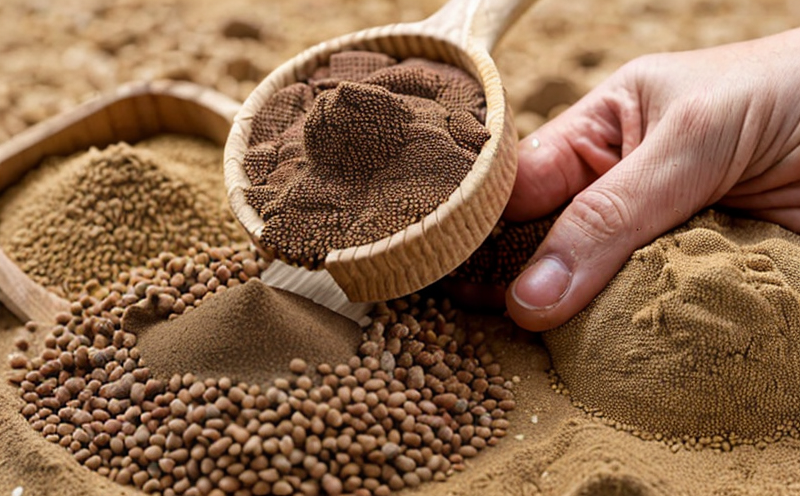Yeast and Mold Count Testing in Feed
The quality of animal feed is critical to ensuring optimal performance, health, and safety in livestock production. Yeast and mold count testing plays a pivotal role in safeguarding the integrity of animal feeds by detecting potential contaminants that could compromise nutritional value or pose risks to animals.
Yeast cells are microscopic fungi that can naturally occur in feed ingredients such as grains, cereals, and oilseeds. While some yeasts can be beneficial, high yeast counts may indicate spoilage or poor storage conditions. Molds, on the other hand, produce toxins known as mycotoxins which can have serious health implications for animals if present in excessive quantities.
Inadequate control of yeast and mold growth not only affects feed quality but also has broader economic impacts on farm productivity. Excess mold and yeasts can lead to reduced palatability, increased spoilage rates, and diminished nutritional value. Moreover, they are potential sources of mycotoxins that pose significant health risks for animals.
Accurate yeast and mold count testing is essential for maintaining high standards in the production process. It ensures that feeds meet regulatory requirements and industry best practices. By implementing robust testing protocols early on, producers can minimize risks associated with microbial contamination, thereby enhancing overall feed quality.
The testing procedure involves several key steps: sampling of feed samples, preparation using appropriate methods like dilution or homogenization, inoculation onto specialized media capable of supporting yeast and mold growth, incubation at optimal temperatures, followed by quantification through microscopic examination or automated colony counters. Advanced technologies such as flow cytometry can also be employed for precise enumeration.
Compliance with international standards like ISO 11290:2015 ensures consistency across laboratories worldwide. These guidelines provide clear instructions on sample handling, culture conditions, and interpretation of results. Proper adherence to these standards guarantees reliable data which is crucial when making informed decisions regarding feed quality.
Regular monitoring of yeast and mold levels helps identify potential issues early enough so corrective actions can be taken promptly. This proactive approach prevents costly recalls or disruptions in supply chains while protecting both animal welfare and consumer trust in the products being produced.
Why It Matters
The importance of yeast and mold count testing cannot be overstated, especially within the context of agricultural and forestry sectors where feed safety is paramount. Contamination from these microorganisms can have far-reaching effects on animal health, productivity, and profitability.
- Prevents Mycotoxin Formation: Yeasts and molds often serve as precursors to mycotoxins—poisonous compounds that can harm animals if ingested. By controlling yeast and mold growth early in the production cycle, potential mycotoxin formation is minimized.
- Promotes Animal Health: Ensuring low levels of contaminants reduces stress on livestock, leading to healthier animals with better feed efficiency and overall welfare.
- Enhances Feed Palatability: High yeast counts can negatively impact the taste and aroma of feeds, making them less appealing. Maintaining proper counts ensures that animals will consume their rations as intended.
- Maintains Product Integrity: Consistent testing throughout the supply chain helps maintain uniform quality standards across batches, ensuring reliable performance from one batch to another.
These benefits translate into tangible advantages for producers and consumers alike. Improved feed quality translates directly into higher yields and better returns on investment. Ultimately, this contributes to more sustainable agricultural practices that support long-term economic growth within the industry.
Why Choose This Test
- Comprehensive Analysis: Our comprehensive approach ensures accurate detection of both yeast and mold populations, providing a holistic view of feed quality.
- ISO Compliance: We strictly adhere to international standards like ISO 11290:2015 ensuring reliable results that are universally accepted.
- Precision Instruments: Utilizing advanced technology such as flow cytometers guarantees precise quantification of microorganisms present in feed samples.
- Expertise: Our team comprises highly trained professionals specializing in agricultural testing, bringing extensive knowledge to bear on every project.
- Timely Reporting: Results are delivered promptly allowing for quick response times necessary when addressing emerging issues within the feed supply chain.
- Eco-Friendly Methods: We employ environmentally friendly techniques that minimize waste and reduce the carbon footprint associated with our services.
International Acceptance and Recognition
The global nature of agriculture means that compliance with international standards is crucial for maintaining credibility among buyers and sellers alike. Our laboratory adheres to stringent ISO guidelines which ensure our methodologies are consistent across borders.
Achieving and maintaining ISO 17025 accreditation demonstrates our commitment to quality assurance and continuous improvement within the testing environment. This certification underscores our capability to deliver reliable, reproducible results that meet or exceed customer expectations.
Our participation in proficiency testing programs further reinforces our reputation as a trusted partner for feed safety testing worldwide. Regular participation ensures alignment with current trends and best practices while fostering innovation within our operations.





